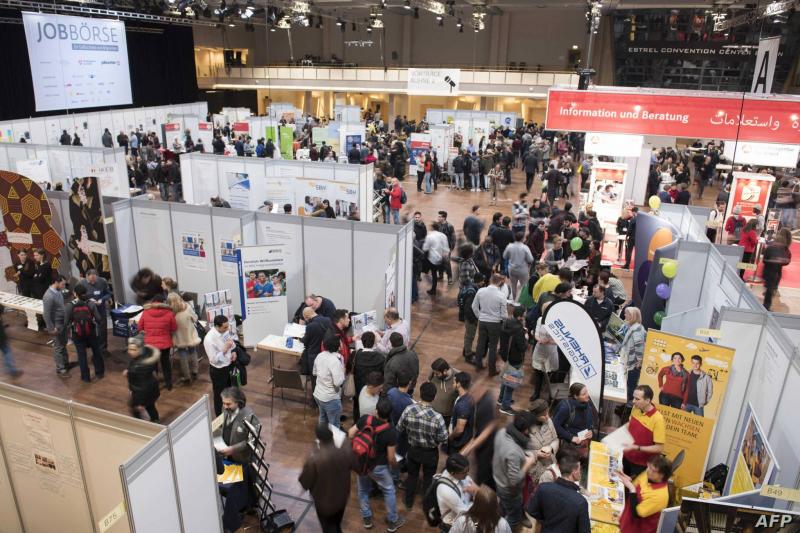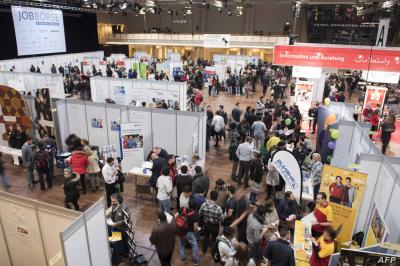The COVID-19 pandemic has cast a shadow over the labor market, as the disruptions caused by the virus led many individuals to retire, resign, or simply not return to work, creating a significant imbalance in wealthy countries that are struggling to recover. This has sparked competition to employ, train, and integrate foreigners, as well as to attract skilled migrants, according to a report by "The New York Times."
In Germany, officials recently warned that the country needs 400,000 new migrants annually to fill jobs in various fields, ranging from academics to technicians in areas such as air conditioning. The new immigration law provides expedited work visas and six months for visiting and finding a job. Canada plans to grant residency to 1.2 million new migrants by 2023. Recently, Israel completed a deal to bring healthcare workers from Nepal. In Australia, where mines, hospitals, and pubs are struggling after nearly two years of closed borders, the government aims to double the number of migrants allowed into the country over the next year.
**Imbalance**
The newspaper notes that the COVID-19 pandemic has revealed a demographic imbalance in humanity, stating, "Rapidly aging wealthy countries produce very few new workers, while countries with a surplus of youth often lack job opportunities." It adds that "the pandemic has led to many significant changes in global mobility, slowing labor migration and creating fierce competition among several countries for skilled labor, particularly in technology." It reveals that against the backdrop of a shortage of trained workers, more than 30 countries, including Croatia and the United Arab Emirates, have established programs to attract mobile technology workers or relaxed work rules for foreigners who have already moved.
Many countries, including Belgium, Finland, and Greece, have granted work rights to foreigners who arrived on student visas or other permits. Some countries, like New Zealand, have indefinitely extended temporary work visas. Meanwhile, Germany, through its new immigration law, has accelerated the process of recognizing foreign professional qualifications. In Japan, a country that is aging rapidly and traditionally resistant to immigration, the government has allowed temporary workers to change employers while retaining their status.
The newspaper quotes Jean-Christophe Dumont, head of international migration research at the OECD, stating, "Countries had to recognize the importance of immigration and migrants." However, this competition occurs at a time when there remains a divide on how to handle new waves of asylum seekers in Europe, such as at the Polish border, or in the United States at the border with Mexico. The Brexit has restricted the access of migrants from Europe. A survey of 5,700 companies in June found that 70 percent struggled to hire new employees. In Australia, mining companies have reduced profit expectations due to a labor shortage, and there are around 100,000 job openings in the hospitality sector alone. In the United States, the U.S. Chamber of Commerce has urged policymakers to reform the immigration system to allow more work visas and green cards.
**Migrants: A Temporary Solution for the Gap**
U.S. President Joe Biden is attempting to reform from within first. The social policy law proposed by his administration, valued at $2.2 trillion, if passed in the divided Senate, would free up hundreds of thousands of green cards dating back to 1992. Parag Khanna, author of a new book titled "Move," who has advised governments on immigration policy, stated, "It's a war for young talent; there is a clearer and more regulated ladder for residency levels as countries get serious about the need for a balanced demographic and meeting labor shortages."
In this context, Germany has been focusing on labor shortages through migration. Young Germans increasingly prefer to attend universities, and the country's workforce is shrinking. According to a recent study by the German Economic Institute, the country is projected to lose five million workers in the next fifteen years, with 3.2 million lost entirely by 2030. Migrants have become a temporary solution. Approximately 1.8 million refugees have lived in Germany for three years. Over time, the country has tried to improve how it integrates both asylum seekers and foreigners with work visas.
**Attraction Factors**
Recently, vocational training centers in Germany have sought to develop refugees. In classrooms and workplaces, they have learned to become professional hairdressers, electricians, carpenters, welders, painters, mechanics, and machine operators. The costs of programs, lasting between 24 and 28 months, are covered by the local employment office, which also pays for housing and living expenses. To enter this program, candidates must first take an integration course and a language course, also funded by the German government.
For instance, Sergey Lesenyuk, a 40-year-old who came to Germany from Moldova in 2015, began training as a machinery mechanic, which will soon provide him with stable employment and a higher salary. Dumont says, "If you want to attract new workers, you have to provide them with appealing conditions." However, despite the gains made by some workers and some countries, economists and demographers believe that labor market gaps will persist and widen, revealing how much more needs to be done to manage the global imbalance not only in population but also in development.




